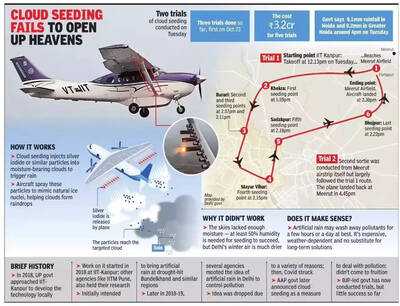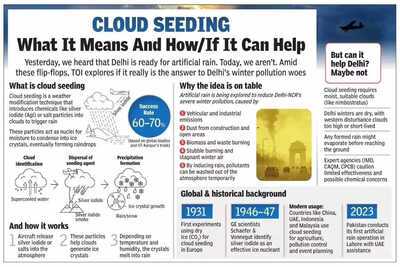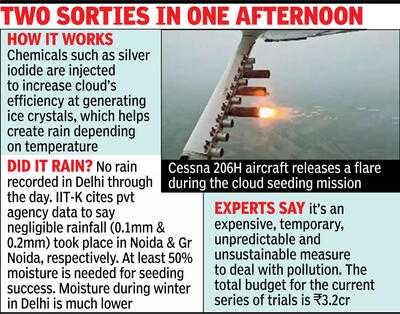In the X-Men universe, an Omega-level mutant is defined as one whose dominant power has no upper limit. Among them was Ororo Munroe , better known by her moniker Storm , who could make it rain at will because she could control the entire planetary ecosystem. This led Magneto, in the X-Men ’97 reboot, to refer to her as the closest thing to a divine being, which in essence is what humans have been trying to do since we arrived on earth. We have managed to fly distant continents, split the atom, create antimatter, build machines that mimic the mind, map the human genome, reach the moon, grow meat without animals and diamonds in a lab — but we still struggle to, like Storm, make it rain at will.
And yet, every so often, we try. From Beijing to Dubai, humans have spent decades firing silver iodide into clouds, hoping to bend the weather to our will. The latest to attempt this act of atmospheric persuasion was Delhi — a city so desperate for clean air it decided to summon rain from a clear sky.
The Experiment: Delhi Tries to Play Storm
As the capital’s air turned toxic this October, officials tried what man dreams of – making it rain. The Delhi government signed a memorandum of understanding with IIT-Kanpur for a ₹3.2 crore cloud-seeding project, costing roughly ₹64 lakh per trial. The plan: send small Cessna planes to spray silver iodide flares into the sky, hoping to coax moisture from passing clouds.
After three sorties over north Delhi, no significant rainfall was recorded. The Air Quality Index stayed locked in the “poor” to “very poor” range. It wasn’t the first time Delhi tried this; earlier attempts in 1957 and the 1970s had fizzled out too. Seven decades later, the capital cannot summon rain.
The Good: When Cloud-Seeding Actually Works
To be fair, cloud-seeding is real science, not magic. The idea dates back nearly a century. By dispersing tiny particles — typically silver iodide or dry ice — into moisture-rich clouds, scientists can trigger condensation, forming heavier droplets that fall as rain. Under the right conditions, studies show seeding can boost rainfall by 5–15%.

India’s own experiments have produced promising results. The IITM’s CAIPEEX programme over drought-prone Maharashtra recorded rainfall increases of up to 46% on seeded days. Research by IIT-Kanpur and the IMD also found measurable gains when the atmosphere was suitably humid.
Other countries have gone further. China, the UAE, Indonesia, Malaysia and even Pakistan regularly conduct cloud-seeding operations — to induce rain for agriculture, combat smog, or clear skies before major events. The principle is straightforward: if clouds are ripe, give them a nudge.
In short:
If Delhi’s skies had resembled monsoon season, the plan might have bought the city a brief reprieve. Unfortunately, nature didn’t cooperate.

The Bad: Why Delhi’s Skies Refused
The failure wasn’t surprising. The skies above Delhi simply didn’t have enough to give. Humidity during the trials hovered around 20%. The clouds themselves carried only about 15–20% moisture — far too little for the silver iodide particles to latch onto. As one IIT Delhi scientist told TOI, “You can’t seed what isn’t there.” Then there was the cost. Each sortie ran up a bill of around ₹64 lakh. Three flights later, Delhi saw barely 0.1–0.2 mm of drizzle in Noida and NCR . Crores spent, for a few drops on the windshield.
Even if the mission had succeeded, experts warned the impact would have been fleeting. Pollution in Delhi is relentless — driven by vehicles, factories, construction dust and seasonal stubble burning. A passing drizzle might wash away particulates for a few hours, but the smog returns as soon as emissions resume.
Environmentalists called it a gimmick. As one told TOI: “Artificial rain is symbolic, not a real solution." Without curbing pollution at its source, they argue, cloud-seeding is little more than an atmospheric placebo — a photo-op in the sky while the ground burns below.

The Ugly: It never rains, it pours
For a cautionary tale, one need only look west. In April 2024, Dubai was hit by record-breaking floods — a year’s worth of rain in a single day — prompting viral claims that the UAE’s cloud-seeding had gone rogue. Meteorologists quickly debunked it.
As the Associated Press reported, the deluge was purely natural, caused by a large storm system. The UAE’s National Meteorology Centre confirmed that no seeding flights were conducted during the event. “You don’t need cloud seeding ’s influence to account for the record deluge,” noted Yale meteorologist Jeff Masters back then.
Still, the incident was telling. Weather manipulation has always carried the whiff of hubris — the belief that we can outthink chaos. The same misgivings surfaced in Saudi Arabia in 2020, when unseasonal rains sparked rumours of a “seeding disaster.” No evidence emerged, but the perception lingered: tamper with the skies, and you risk taking the blame when nature pushes back.
The Takeaway: The Real Fight Is on the Ground
Delhi’s cloud-seeding project joins a long line of grand, short-lived solutions to deep-rooted problems. Like Dubai’s floods or Beijing’s Olympic “blue sky” campaigns, these attempts make for good optics but poor outcomes.
If India truly wants clean air, it must look down, not up — towards sustained emission cuts, stricter enforcement, and cleaner energy. The technology that could save Delhi already exists on the ground: electric mobility, dust control, crop management. No silver iodide flare can substitute for political will.
Because unlike Storm, we can’t command the weather. And unlike gods, we don’t control chaos. All we can do is face the smoke we made — and start cleaning it up.
And yet, every so often, we try. From Beijing to Dubai, humans have spent decades firing silver iodide into clouds, hoping to bend the weather to our will. The latest to attempt this act of atmospheric persuasion was Delhi — a city so desperate for clean air it decided to summon rain from a clear sky.
The Experiment: Delhi Tries to Play Storm
As the capital’s air turned toxic this October, officials tried what man dreams of – making it rain. The Delhi government signed a memorandum of understanding with IIT-Kanpur for a ₹3.2 crore cloud-seeding project, costing roughly ₹64 lakh per trial. The plan: send small Cessna planes to spray silver iodide flares into the sky, hoping to coax moisture from passing clouds.
After three sorties over north Delhi, no significant rainfall was recorded. The Air Quality Index stayed locked in the “poor” to “very poor” range. It wasn’t the first time Delhi tried this; earlier attempts in 1957 and the 1970s had fizzled out too. Seven decades later, the capital cannot summon rain.
The Good: When Cloud-Seeding Actually Works
To be fair, cloud-seeding is real science, not magic. The idea dates back nearly a century. By dispersing tiny particles — typically silver iodide or dry ice — into moisture-rich clouds, scientists can trigger condensation, forming heavier droplets that fall as rain. Under the right conditions, studies show seeding can boost rainfall by 5–15%.
India’s own experiments have produced promising results. The IITM’s CAIPEEX programme over drought-prone Maharashtra recorded rainfall increases of up to 46% on seeded days. Research by IIT-Kanpur and the IMD also found measurable gains when the atmosphere was suitably humid.
Other countries have gone further. China, the UAE, Indonesia, Malaysia and even Pakistan regularly conduct cloud-seeding operations — to induce rain for agriculture, combat smog, or clear skies before major events. The principle is straightforward: if clouds are ripe, give them a nudge.
In short:
- Cloud-seeding can work when conditions are right — it’s proven science, not science fiction.
- It has history — the first experiments began in the 1930s, and GE scientists refined the silver iodide method in the 1940s.
- It can temporarily clean the air — even light drizzle helps wash particulate matter out of the atmosphere.
If Delhi’s skies had resembled monsoon season, the plan might have bought the city a brief reprieve. Unfortunately, nature didn’t cooperate.
The Bad: Why Delhi’s Skies Refused
The failure wasn’t surprising. The skies above Delhi simply didn’t have enough to give. Humidity during the trials hovered around 20%. The clouds themselves carried only about 15–20% moisture — far too little for the silver iodide particles to latch onto. As one IIT Delhi scientist told TOI, “You can’t seed what isn’t there.” Then there was the cost. Each sortie ran up a bill of around ₹64 lakh. Three flights later, Delhi saw barely 0.1–0.2 mm of drizzle in Noida and NCR . Crores spent, for a few drops on the windshield.
Even if the mission had succeeded, experts warned the impact would have been fleeting. Pollution in Delhi is relentless — driven by vehicles, factories, construction dust and seasonal stubble burning. A passing drizzle might wash away particulates for a few hours, but the smog returns as soon as emissions resume.
Environmentalists called it a gimmick. As one told TOI: “Artificial rain is symbolic, not a real solution." Without curbing pollution at its source, they argue, cloud-seeding is little more than an atmospheric placebo — a photo-op in the sky while the ground burns below.
The Ugly: It never rains, it pours
For a cautionary tale, one need only look west. In April 2024, Dubai was hit by record-breaking floods — a year’s worth of rain in a single day — prompting viral claims that the UAE’s cloud-seeding had gone rogue. Meteorologists quickly debunked it.
As the Associated Press reported, the deluge was purely natural, caused by a large storm system. The UAE’s National Meteorology Centre confirmed that no seeding flights were conducted during the event. “You don’t need cloud seeding ’s influence to account for the record deluge,” noted Yale meteorologist Jeff Masters back then.
Still, the incident was telling. Weather manipulation has always carried the whiff of hubris — the belief that we can outthink chaos. The same misgivings surfaced in Saudi Arabia in 2020, when unseasonal rains sparked rumours of a “seeding disaster.” No evidence emerged, but the perception lingered: tamper with the skies, and you risk taking the blame when nature pushes back.
The Takeaway: The Real Fight Is on the Ground
Delhi’s cloud-seeding project joins a long line of grand, short-lived solutions to deep-rooted problems. Like Dubai’s floods or Beijing’s Olympic “blue sky” campaigns, these attempts make for good optics but poor outcomes.
If India truly wants clean air, it must look down, not up — towards sustained emission cuts, stricter enforcement, and cleaner energy. The technology that could save Delhi already exists on the ground: electric mobility, dust control, crop management. No silver iodide flare can substitute for political will.
Because unlike Storm, we can’t command the weather. And unlike gods, we don’t control chaos. All we can do is face the smoke we made — and start cleaning it up.
You may also like

Shekhar Ravjiani opens up about his struggle with cataract

UK's 'most picturesque railway line' with waterfalls and mountains reopens to tourists

India face mighty Australia in blockbuster Women's World Cup semifinal

Bangladesh tilting deeper into China's security orbit: Report

Chhattisgarh: Bilaspur targets 13,761 families under Ujjwala Yojana 3.0 with stricter eligibility norms






